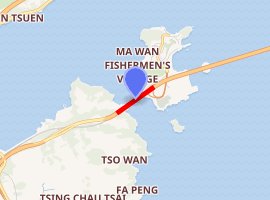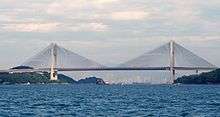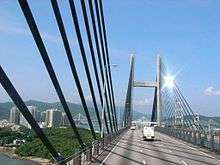Kap Shui Mun Bridge
The Kap Shui Mun Bridge (KSMB) in Hong Kong is one of the longest cable-stayed bridges in the world that transports both road and railway traffic, with the upper deck used for motor vehicles and the lower deck used for both vehicles and the MTR. It has a main span of 430 metres (1,410 ft) and an overall length of 750 metres (2,460 ft). It spans the Kap Shui Mun marine channel between Ma Wan and Lantau and has a vertical clearance of 47 metres (154 ft) above sea level. The bridge was completed in 1997.
Kap Shui Mun Bridge 汲水門大橋 | |
|---|---|
Kap Shui Mun Bridge, with Ma Wan in the foreground | |
| Coordinates | 22°20′39″N 114°03′19″E |
| Carries | 6 lanes of roadway (upper) 2 MTR rail lines, 2 lanes of roadway (lower) |
| Crosses | Kap Shui Mun |
| Locale | Lantau and Ma Wan |
| Other name(s) | KSMB |
| Maintained by | Tsing Ma Management Limited: operation and maintenance contractor for the Tsing Ma Control Area; under contract to the Highways Department of the Government of the Hong Kong[1] |
| Characteristics | |
| Design | Double-decked cable-stayed bridge |
| Total length | 750 metres (2,460 ft) |
| Width | 32.5 metres (107 ft) |
| Longest span | 430 metres (1,410 ft) |
| Clearance below | 47 metres (154 ft) |
| History | |
| Opened | May 22, 1997 |

| |
| Kap Shui Mun Bridge | |||||||||||
|---|---|---|---|---|---|---|---|---|---|---|---|
 Kap Shui Mun Bridge | |||||||||||
| Traditional Chinese | 汲水門大橋 | ||||||||||
| Simplified Chinese | 汲水门大桥 | ||||||||||
| |||||||||||

Structural information
| Main span | 430 m (1,410 ft) |
| Side spans | Two 80 m (260 ft) spans each side |
| Lantau Approach Span | 70 m (230 ft) |
| Ma Wan Viaduct | 503 m (1,650 ft) |
| Overall length | 1,323 m (4,341 ft) |
| Height of towers | 150 m (490 ft) |
| Navigation clearance | 47 m (154 ft) |
The total length of the Kap Shui Mun Bridge includes a 70-metre (230 ft) approach span on the Lantau side. There is a column in each of the back spans of the cable stayed bridge, making four 80-metre (260 ft) spans, adding to the 430-metre (1,410 ft) main span. This makes the total length 820 metres (2,690 ft). The 503-metre (1,650 ft) Ma Wan Viaduct was constructed under the same contract as the KSMB. The viaduct connects the KSMB to the Tsing Ma Bridge, forming the Lantau Link, which was built to provide access to the new airport.[2] The navigation clearance of 47 metres (154 ft) is part of the reason that the H-shaped towers are 150 metres (490 ft) tall.
The Kap Shui Mun Bridge is not symmetrical, in that the 160-metre (520 ft) back span length (two 80-metre (260 ft) spans) is less than half of the main span length (which would be 215 metres (705 ft)). To provide the balance that symmetry will normally provide, part of the bridge has a composite structure. The center 387 metres (1,270 ft) of the main span uses a steel-concrete composite to make the structure lighter. The back spans and the rest of the main span are concrete. Using the lighter steel cross section in the majority of the main span serves to equalize the horizontal forces on the towers and balance the bridge.[3]
Because the lower deck carries both rail and traffic, the cross section is designed as a Vierendeel truss. This means that there are no diagonal members in the cross section and that vehicles and rail cars drive through the openings provided by the Vierendeel design.[3]
Along with the Tsing Ma Bridge and Ting Kau Bridge, it is closely monitored by the Wind and Structural Health Monitoring System (WASHMS).
| Stay cables | |
|---|---|
| Number | 8 X 22 = 176 |
| Total length of stay cables | 11 km (6.8 mi) |
| Movement | |
|---|---|
| Vertical, at midspan | 470 mm (19 in) |
| Lateral, at midspan | 155 mm (6.1 in) |
| Longitudinal, at Pier 1 | 320 mm (13 in) |
Concrete strength of towers: Grade 50/20 or 50MPa
Crane strike
The bridge has a height restriction of 41 metres for vessels passing underneath. On 23 October 2015, a barge attempted to pass under the bridge with a broken-down crane that could not be lowered. The crane had a maximum height of 43 metres, but was tilted slightly to 41 metres. The bridge has an actual clearance of 47 metres, but potentially due to the high tide and wave action, the crane struck the bridge and damaged its underside.[4] The Tsing Ma Bridge has a higher height clearance of 53 metres but a source said the captain of the tugboat towing the barge may have opted to take Kap Shui Mun to save time.[4]
The strike triggered the Ship Impact Detection System to issue an alarm and both the road and railway were shut down immediately, severing Lantau Island and the airport from the city from about 7:40 pm to 10:00 pm.[5] The government's contingency plan to implement emergency ferry service between Tsuen Wan and Tung Chung failed as the ferry operator took almost two hours to ready the service.[5] Some travelers attempted to reach the airport via the Discovery Bay Ferry Pier, although many missed their flights.
The Highways Department inspected the bridge and found that only the inspection platform rails were damaged by the collision, and that the structural integrity of the bridge was not jeopardised.[6] In the days following the incident there were calls in local media for the government to build a second link to the airport. In fact, such a link is already under construction: the Tuen Mun–Chek Lap Kok Link is a road tunnel being built as part of the Hong Kong–Zhuhai–Macau Bridge project.
See also
- List of bridges in Hong Kong
References
- Hong Kong Factsheet: Transport
- Highways Department of the Government of the Hong Kong Special Administrative Region. "Lantau Link project page". Archived from the original on 2007-04-17. Retrieved 2007-06-16.
- Leonhardt, Andrä und Partner, Consulting Engineers VBI, GmbH. "Kap Shui Mun Bridge project page". Archived from the original on 2007-09-28. Retrieved 2007-06-16.CS1 maint: multiple names: authors list (link)
- Lo, Clifford; Lai, Ying-kit (27 October 2015). "Hong Kong airport bridge collision: Tug captain 'may have ignored height limit'". South China Morning Post.
- Yeung, SC (26 October 2015). "Lantau Link traffic chaos: What are the lessons?". Hong Kong Economic Journal.
- "Highways Department completes the inspection of Kap Shui Mun Bridge". Hong Kong Government. 24 October 2015.
External links
| Wikimedia Commons has media related to Kap Shui Mun Bridge. |
| Preceded by Ma Wan Viaduct |
Hong Kong Route 8 Kap Shui Mun Bridge |
Succeeded by North Lantau Highway |